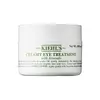What's inside
What's inside
 Key Ingredients
Key Ingredients

 Benefits
Benefits

 Concerns
Concerns

 Ingredients Side-by-side
Ingredients Side-by-side

Collagen Extract 80%
Skin ConditioningGlycerin
HumectantNiacinamide
Smoothing1,2-Hexanediol
Skin ConditioningWater
Skin ConditioningDimethicone
EmollientHydrogenated Polydecene
EmollientButylene Glycol
HumectantTriethylhexanoin
MaskingCetearyl Alcohol
EmollientSodium Acrylate/Sodium Acryloyldimethyl Taurate Copolymer
Emulsion StabilisingPolyglyceryl-3 Methylglucose Distearate
EmulsifyingCyclopentasiloxane
EmollientButyrospermum Parkii Butter
Skin ConditioningDimethicone/Vinyl Dimethicone Crosspolymer
Skin ConditioningIsohexadecane
EmollientSodium Polyacrylate
AbsorbentAmmonium Acryloyldimethyltaurate/Vp Copolymer
Glyceryl Caprylate
EmollientPolysorbate 80
EmulsifyingHydrogenated Lecithin
EmulsifyingGlycosaminoglycans
EmollientAdenosine
Skin ConditioningCarbomer
Emulsion StabilisingSorbitan Oleate
EmulsifyingAllantoin
Skin ConditioningPolysorbate 20
EmulsifyingSteareth-20
CleansingGlycine
BufferingSerine
MaskingGlutamic Acid
HumectantGold
Cosmetic ColorantAspartic Acid
MaskingLeucine
Skin ConditioningAlanine
MaskingPalmitoyl Tripeptide-1
Skin ConditioningLysine
Skin ConditioningArginine
MaskingTyrosine
MaskingPhenylalanine
MaskingThreonine
Proline
Skin ConditioningValine
MaskingN-Hydroxysuccinimide
Skin ConditioningIsoleucine
Skin ConditioningPalmitoyl Tetrapeptide-7
Skin ConditioningPolyglyceryl-10 Stearate
Skin ConditioningHistidine
HumectantCysteine
AntioxidantMethionine
Skin ConditioningLactobacillus Ferment Lysate
Skin ConditioningPanthenol
Skin ConditioningBeta-Glucan
Skin ConditioningPCA
HumectantCaprylyl Glycol
EmollientTaraxacum Officinale Leaf Extract
Skin ConditioningTocopheryl Acetate
AntioxidantSodium Ascorbyl Phosphate
AntioxidantGlycine Soja Protein
EmulsifyingGlyceryl Arachidonate
EmollientAcetyl Hexapeptide-8
HumectantBiotin
AntiseborrhoeicRetinyl Palmitate
Skin ConditioningFolic Acid
Skin ConditioningThiamine Hcl
MaskingPyridoxine
Skin ConditioningCyanocobalamin
Skin ConditioningChlorphenesin
AntimicrobialDisodium EDTA
Collagen Extract 80%, Glycerin, Niacinamide, 1,2-Hexanediol, Water, Dimethicone, Hydrogenated Polydecene, Butylene Glycol, Triethylhexanoin, Cetearyl Alcohol, Sodium Acrylate/Sodium Acryloyldimethyl Taurate Copolymer, Polyglyceryl-3 Methylglucose Distearate, Cyclopentasiloxane, Butyrospermum Parkii Butter, Dimethicone/Vinyl Dimethicone Crosspolymer, Isohexadecane, Sodium Polyacrylate, Ammonium Acryloyldimethyltaurate/Vp Copolymer, Glyceryl Caprylate, Polysorbate 80, Hydrogenated Lecithin, Glycosaminoglycans, Adenosine, Carbomer, Sorbitan Oleate, Allantoin, Polysorbate 20, Steareth-20, Glycine, Serine, Glutamic Acid, Gold, Aspartic Acid, Leucine, Alanine, Palmitoyl Tripeptide-1, Lysine, Arginine, Tyrosine, Phenylalanine, Threonine, Proline, Valine, N-Hydroxysuccinimide, Isoleucine, Palmitoyl Tetrapeptide-7, Polyglyceryl-10 Stearate, Histidine, Cysteine, Methionine, Lactobacillus Ferment Lysate, Panthenol, Beta-Glucan, PCA, Caprylyl Glycol, Taraxacum Officinale Leaf Extract, Tocopheryl Acetate, Sodium Ascorbyl Phosphate, Glycine Soja Protein, Glyceryl Arachidonate, Acetyl Hexapeptide-8, Biotin, Retinyl Palmitate, Folic Acid, Thiamine Hcl, Pyridoxine, Cyanocobalamin, Chlorphenesin, Disodium EDTA
Water
Skin ConditioningButyrospermum Parkii Butter
Skin ConditioningButylene Glycol
HumectantTridecyl Stearate
EmollientPEG-30 Dipolyhydroxystearate
EmulsifyingIsodecyl Salicylate
Skin ConditioningTridecyl Trimellitate
EmollientPersea Gratissima Oil
Skin ConditioningIsocetyl Stearoyl Stearate
EmollientPropylene Glycol
HumectantDipentaerythrityl Hexacaprylate/Hexacaprate
EmulsifyingSorbitan Sesquioleate
EmulsifyingMagnesium Sulfate
Hydrogenated Castor Oil
EmollientSodium PCA
HumectantPhenoxyethanol
PreservativeChlorphenesin
AntimicrobialHydrogenated Jojoba Oil
AbrasiveP-Anisic Acid
MaskingTocopheryl Acetate
AntioxidantIsopropyl Palmitate
EmollientDisodium EDTA
Copper PCA
HumectantHelianthus Annuus Seed Oil
EmollientCI 40800
Cosmetic ColorantCitric Acid
BufferingWater, Butyrospermum Parkii Butter, Butylene Glycol, Tridecyl Stearate, PEG-30 Dipolyhydroxystearate, Isodecyl Salicylate, Tridecyl Trimellitate, Persea Gratissima Oil, Isocetyl Stearoyl Stearate, Propylene Glycol, Dipentaerythrityl Hexacaprylate/Hexacaprate, Sorbitan Sesquioleate, Magnesium Sulfate, Hydrogenated Castor Oil, Sodium PCA, Phenoxyethanol, Chlorphenesin, Hydrogenated Jojoba Oil, P-Anisic Acid, Tocopheryl Acetate, Isopropyl Palmitate, Disodium EDTA, Copper PCA, Helianthus Annuus Seed Oil, CI 40800, Citric Acid
 Reviews
Reviews

Alternatives
Ingredients Explained
These ingredients are found in both products.
Ingredients higher up in an ingredient list are typically present in a larger amount.
Butylene Glycol (or BG) is used within cosmetic products for a few different reasons:
Overall, Butylene Glycol is a safe and well-rounded ingredient that works well with other ingredients.
Though this ingredient works well with most skin types, some people with sensitive skin may experience a reaction such as allergic rashes, closed comedones, or itchiness.
Learn more about Butylene GlycolThis ingredient is also known as shea butter. It is an effective skin hydrator and emollient.
Emollients help soothe and soften your skin. It does this by creating a protective film on your skin. This barrier helps trap moisture and keeps your skin hydrated. Emollients may be effective at treating dry or itchy skin.
Shea butter is rich in antioxidants. Antioxidants help fight free-radicals, or molecules that may harm the body. It is also full of fatty acids including stearic acid and linoleic acid. These acids help replenish the skin and keep skin moisturized.
While Shea Butter has an SPF rating of about 3-4, it is not a sunscreen replacement.
Shea butter may not be fungal acne safe. We recommend speaking with a professional if you have any concerns.
Learn more about Butyrospermum Parkii ButterChlorphenesin is a synthetic preservative. It helps protect a product against bacteria in order to extend shelf life. In most cases, Chlorphenesin is paired with other preservatives such as phenoxyethanol and caprylyl glycol.
Chlorphenesin is a biocide. This means it is able to help fight the microorganisms on our skin. It is also able to fight odor-releasing bacteria.
Chlorphenesin is soluble in both water and glycerin.
Studies show Chlorphenesin is easily absorbed by our skin. You should speak with a skincare professional if you have concerns about using Chlorphenesin.
Learn more about ChlorphenesinDisodium EDTA plays a role in making products more stable by aiding other preservatives.
It is a chelating agent, meaning it neutralizes metal ions that may be found in a product.
Disodium EDTA is a salt of edetic acid and is found to be safe in cosmetic ingredients.
Learn more about Disodium EDTATocopheryl Acetate is AKA Vitamin E. It is an antioxidant and protects your skin from free radicals. Free radicals damage the skin by breaking down collagen.
One study found using Tocopheryl Acetate with Vitamin C decreased the number of sunburned cells.
Tocopheryl Acetate is commonly found in both skincare and dietary supplements.
Learn more about Tocopheryl AcetateWater. It's the most common cosmetic ingredient of all. You'll usually see it at the top of ingredient lists, meaning that it makes up the largest part of the product.
So why is it so popular? Water most often acts as a solvent - this means that it helps dissolve other ingredients into the formulation.
You'll also recognize water as that liquid we all need to stay alive. If you see this, drink a glass of water. Stay hydrated!
Learn more about Water